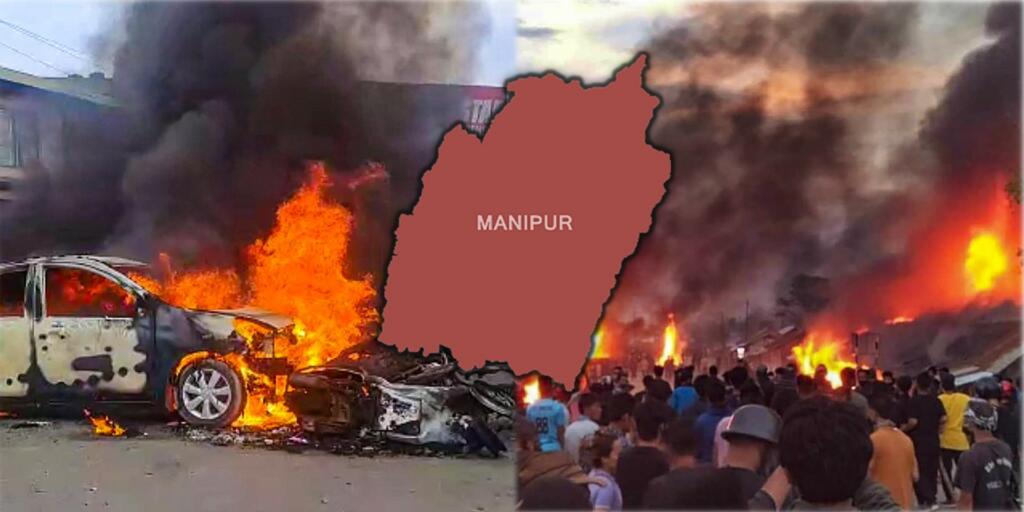Manipur Violence: Looks like the ‘Soros Project’ has been activated. As anarchists threaten to lay siege to Delhi following a failed to attempt to corner the Central Government through the farce of a “Wrestler’s Protest”, now the North East is their next punching bag. Don’t believe us, then check out the unrest in Manipur.
Violence: Manipur and the Meiteis
Recently, riots broke out in Manipur over the ST status being given to Meiteis. Until celebrated boxer MC Mary Kom chose to tweet about it, not many were even ready to focus on this unrest. Following the deteriorating situation, the state government called in for armed forces, who have somehow brought the violent unrest to a standstill.
But what is this fuss all about? To be honest, one needs to have a look into the history of Manipur before going ahead. Literally meaning “the land of ornaments”, Manipur was a princely state during the British rule. It was merged in September 1949 when the king of Manipur, Bodhchandra Singh, signed the letter of the merger.
Manipur was granted the status of a complete state on January 21, 1972, when a constituency of 60 elected members was established. At present, it has 2 Lok Sabha and 1 Rajya Sabha seat.
Now, Meitei community are the original inhabitants of the state. According to Indian Express, Manipur has 65% population belonging to the Meitei community while they have only 10% of the land. These people mainly live in the valley in and around Imphal. Thus, they feel pressure for the land. Meitei community is a prominent community of Manipur and it has a history of prosperous heritage. Incidentally, MC Mary Kom, though a Christian, herself belongs to the same tribe.
Also read: You saw the tears of Sakshi Malik, but not the heckling of PT Usha and other sporting legends
Manipur Violence: Kukis and the missionary connection
On the other hand, about 35% of the Manipuri population belongs to around 34 tribes of the Kuki-Naga community. About 90% of the total land is reserved for the Kuki-Naga tribe, according to land allocation records it is evident that 10% of the land is for 65% population (Meitei community) and the rest 90% land is for 35% of the population (Kuki-Naga tribes). Kuki-Naga people live in mountainous regions.
With time, the Kuki-Naga community have adopted the cultivation and trade of Opium as their main source of livelihood. It leads to illegal consumption that has spread as a system from Manipur to Myanmar, Laos and Cambodia. Currently, the present government adopted a ‘zero tolerance’ policy for the cultivation of opium and other similar substances.
Another factor that is causing an issue is Clause 371 (C) of the Indian Constitution, under which the mountainous regions of Manipur have been conserved. Private property is strictly prohibited in these conserved forest areas. But in time, the Christian Kuki-Naga people established their huts one by one in these protected areas and developed the villages.
They started to convert, occupy the land for opium production and suddenly become millionaires. The current government has desolated several such manufactured villages. Long story short, the majority Meiteis have been suppressed by the minority Kukis, who have connections to both the cartels as well as the missionaries.
Also read: Virat Kohli is now “Kannada Gaurav” and Congress’ last desperate attempt
Tribal Status to the Meiteis and the violence that engulfed the state
Recently, while hearing a Meitei Tribe Union petition, the officiating Chief Justice of the High Court, M. Muralidharan, directed the state government to present on April 19, as the recommendation of Union Ministry of Tribal Affairs pending for 10 years. The recommendation tells for a tribal status for the Meitei community. In May 2013, the Honorable High Court referenced a letter from the Union Ministry of Tribal Affairs.
However, for reasons best known to them, the incumbent Congress government turned a blind eye to the same. Earlier the petitioners informed the court that the community had a tribal status before Manipur merged into the Indian Federation in 1949.
Now that the Meiteis were given their dues, this infuriated the missionary nexus, who wanted to encroach upon the rights of the people of Manipur. The houses of the Meitei Hindu People were burnt in this regard. This combination of churches indulged in conversion, foreign currency and narcotic crimes has done great mischief during the last 100 years in North-East India. In 1901 there were 96% of Hindus in the Manipuri population while it has reduced to 49% in 2021.
Support TFI:
Support us to strengthen the ‘Right’ ideology of cultural nationalism by purchasing the best quality garments from TFI-STORE.COM
